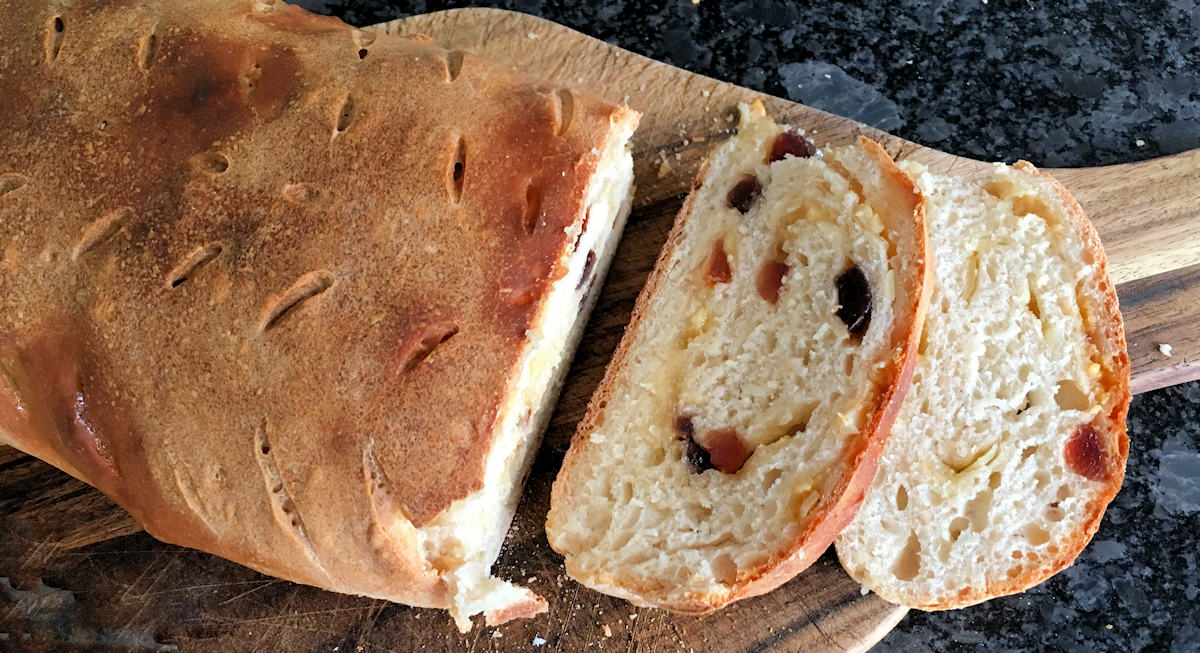What a delightful breakfast idea: sweet brioche filled with a mix of white chocolate chips, glace cherries and almond flakes. This is brioche made with sourdough starter but just as easy and equally delicious when leavened with baker’s yeast.

Hit and miss, but I love it
Bread making is funny: it seems like a complete black magic and hocus-pocus when uninitiated.
But once you know your way around the starters, levains (and learn how to pronounce them) or ferments, you find you can experiment, ad lib and succeed.
Of course sometimes you will follow a ten times tried and twenty times tested recipe and it will result in a cannonball-textured pancake, but that’s precisely what makes it interesting.
I’ve been obsessed with those YouTube videos showing bread making. It’s thoroughly fascinating to watch enormous amounts of dough being kneaded, flipped this way and that, rolled and unrolled, stretched and twisted, going for a ride on conveyor belts or twirling and swirling in gigantic vats.
The one that inspired this recipe was from a bakery in Anchorage, Alaska, with bread dough rising magically from the worktops. Completely enthralling.
Sourdough or yeast?
This is a recipe using a sourdough starter but – unless you’re a sourdough fanatic – it’s easy to adapt it for commercial yeast.
I’m convinced the taste isn’t affected – though to be honest I’ve not tried both versions side by side, as there’s no other way of properly comparing the two. As much as sourdough bread is unparalleled in flavour, sweet dough or tea cakes just need to be airy and tasty.
I have a strong suspicion that there’s a lot of snobbery going on in the sourdough world.
How to swap sourdough for yeast?
How to adapt this and other formulae for yeasted versions? Easy: sourdough starter is usually half liquid half flour so increase those ingredients amounts accordingly.
My cherry bread calls for 150g of starter so you will need 75g more flour and 75g liquid – buttermilk in this instance, but water would be fine too. How much yeast?
For sweet dough it will normally be about 10g fresh or a teaspoon of instant yeast per 250g of flour, increased for very rich dough like panettone.
How to make the rich brioche dough
Whether you use a recently refreshed sourdough starter or just want to use yeast, stir either into buttermilk brought to room temperature, with some honey.
The liquid should then be mixed into the flours, the combination of which, plain and strong, is to make it more similar to French, finely milled patisserie flour #45.
Having mixed the rough dough with your hands or with the help of a standing mixer, let it rest a while before adding salt and a little warm milk, to help the salt distribute evenly in the dough.
The development of gluten structure in this instance is done through stretching and folding of the dough, four or five stints at half an hour intervals. At the end of this stage the dough should be pillowy and increased in volume by at least thirty percent.
Filling for the chocolate bread
The combination I use is the best: glace cherry chunks, white chocolate chips and flaked almonds. But that’s of course just my opinion: if your preference is for chopped apricots and dark chocolate, absolutely go for it. Any dried fruit though will benefit from being tossed in some flour, to stop it from clumping.
Other variants of this brioche-bread might include a jam filling – though the dough layers tend to split and separate around jam filling – or Nutella or a similar spread.
How to fill the dough
After all the stretching and folding the dough needs to rest in order to relax before being rolled out to a large rectangle.
The filling should be scattered over it evenly and generously, and the dough rolled up with the filling into a tight, fat log, the seam secured by pinching. You can also drop the log into a large loaf tin brushed with butter.
The final proof or rising takes about an hour and the chocolate bread bakes for about forty minutes. It’s absolutely divine when warm, fresh out of the oven, just cooled slightly so you don’t get burnt with hot filling.
It will keep quite well for a few days and can be refreshed in slices, on top of a toaster or in a warm oven.
More brioche recipes
Buttery and barely sweet brioche, home baked breakfast fit for a king. Paper-thin glossy crust and the softest, meltiest crumb hiding inside, waiting only for a lick of good jam.
Chocolate braided bread, made from two-coloured dough. This braided chocolate brioche is very much like chocolate babka, braided and cut to reveal the coloured swirl. Chocolate brioche braid can be baked into a wreath as well.
Soft and rich brioche base with plums and cinnamon crumble topping. It means brioche is not just for breakfast. It means turning bread into cake!
More sweet bread recipes
Yorkshire teacakes, with raisins or currants, toasted and buttered are the best tea time treat. And they are really easy to make.
Pompe à huile, sweet olive oil brioche traditionally served in Provence, South-East France, at Christmas. With orange flavour and a strange name (‘oil pump’), it’s one of 13 Provençal Christmas desserts.
Boller are Norwegian breakfast buns with cardamom flavour and a shiny glaze. Easy to make, they are gorgeous warm but as lovely toasted and buttered.